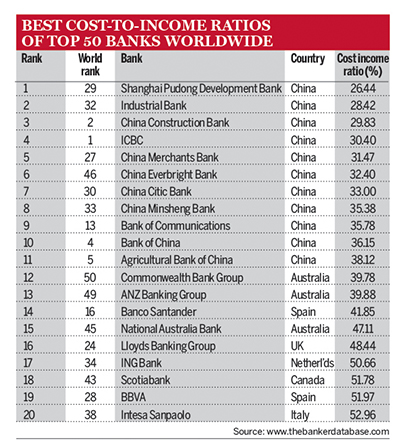If evidence were still required that China now dominates the world of banking, its lead in The Banker’s Top 1000 cost-to-income ratio ranking may be it. Chinese banks top the ranking of most efficiently run lenders to such an overwhelming degree that it is only in 12th position where a bank of a different nationality makes an appearance. With a cost-to-income ratio of 26.44%, Shanghai Pudong Development Bank leads the pack. It is also the world’s 29th largest bank by Tier 1 capital.
China Construction Bank, ICBC, Bank of China and Agricultural Bank of China – four of the top five names in the global ranking by Tier 1 capital – have scored well in terms of efficiency too, and all appear towards the top of the cost-to-income table. Shanghai Pudong Development Bank (SPDB) has shown a marked improvement from the 28.73% ratio it scored in the 2015 ranking, and a notable one from the 46.49% of the 2014 ranking.
Indeed, this result warrants closer inspection. SPDB’s ratio moved because of operating costs growing by a smaller margin than the growth of operating income, highlighting the bank’s efforts to become more efficient. However, there is another side to this improvement. Because of its development mandate, SPDB does not place emphasis on securing returns but rather on supporting its stakeholders’ activities. It may raise concern, therefore, if the lending activity falls behind. Despite lower income growth, the efficiency ratio fell as a result of lower costs, according to The Banker Database, amid the wider context of China’s cooling economy. Both the loans-to-asset and the loans-to-deposit ratios shrank during the 2015 financial year.
In the lower half of the table, Commonwealth Bank Group is the best scoring non-Chinese name. The Australian lender has very slightly improved efficiency ratio of 39.78%, which puts it in 12th place, three steps up from its 2015 position. In this case, the improvement was due to costs shrinking more quickly than income. Commonwealth Bank’s profitability, however, remains high, with a 30.65% return-on-capital ratio and a 1.44% return on assets – the first and second highest, respectively, among Australia’s largest banks.
There are two other Australian names in the table. ANZ Banking Group, in 13th place, rose one place with an almost unchanged efficiency score from the 2015 ranking. National Australia Bank, in 15th place, managed to rise five places in the ranking die to losing a few percentage points.
Madrid-based Banco Santander is the highest scoring of the five European banks in the list, with a 41.85% ratio – a figure that has deteriorated slightly since the previous ranking. The group’s main markets have continued to suffer a number of setbacks, particularly in Latin America, which has traditionally been an important source of income for Santander. In Brazil, for example, the bank’s cost-to-income spiked to 47.71% during 2015, 7.94 percentage points higher than a year earlier. Worse, as the country dealt with 2015’s deep recession, Santander Brazil closed its annual report with a pre-tax loss – although a tax rebate moved it back into the black, securing a net profit for the year.
ING Bank and Lloyds Banking Group are the most improved in the list. ING has cut an impressive 11.09 percentage points from its cost-to-income quotient, which is now 50.66%; while Lloyds has slimmed down by 5.37 percentage points to 48.44%.
Generally, the average cost-to-income ratio for the 20 most efficient banks has risen to 39.1%, compared to 38.21% in the 2015 ranking.
More banks from developed economies have made the cut in the 2016 ranking, leaving Chinese lenders the only representatives of emerging markets.






